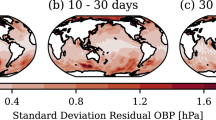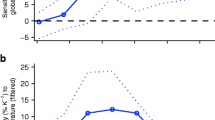Abstract
Over the past few decades, band-pass filtered (BP) variance statistics have been widely used as indicators of storm track activity. A recent study suggested that these statistics may be subjected to biases related to Doppler shifting of variance into and out of the fixed frequency band, in the process perhaps greatly exaggerating the correlation between BP variance and mean flow variability. In this study, BP statistics are examined together with other storm track measures to assess whether BP variances are useful indicators of the patterns of storm track activity. Storm track variability related to the North Atlantic Oscillation, as well as the five leading EOFs of 300 hPa BP filtered variance statistics, have been examined. Results presented here suggest that BP variance statistics are useful measures of the patterns of storm track activity. Firstly, BP variance statistics largely reflect changes in total unfiltered transient eddy variance as well as spatially filtered statistics. Secondly, different BP statistics all give qualitatively similar patterns. Thirdly, patterns derived from BP statistics are well correlated (spatially) with precipitation anomalies. In addition, BP statistics are straightforward to compute, and easily reproducible. Moreover, BP variance and covariance statistics are closely related to how storm tracks interact with the large scale circulation. However, results shown in this paper support the suggestion that some biases may be caused by the Doppler effect, especially for variations such as the NAO which are tightly tied to changes in the background flow speed. Thus it is argued that BP statistics should be examined together with other measures of storm track activity to obtain a broader perspective on storm track variations.















Similar content being viewed by others
References
Blackmon ML (1976) A climatological spectral study of the 500 mb geopotential height of the Northern Hemisphere. J Atmos Sci 33:1607–1623. doi: 10.1175/1520-0469(1976)033<1607:ACSSOT>2.0.CO;2
Blackmon ML, Wallace JM, Lau N-C, Mullen SL (1977) An observational study of the Northern Hemisphere wintertime circulation. J Atmos Sci 34:1040–1053. doi:10.1175/1520-0469(1977)034<1040:AOSOTN>2.0.CO;2
Branstator G (1992) The maintenance of low-frequency atmospheric anomalies. J Atmos Sci 49:1924–1945. doi:10.1175/1520-0469(1992)049<1924:TMOLFA>2.0.CO;2
Branstator G (1995) Organization of storm track anomalies by recurring low frequency circulation anomalies. J Atmos Sci 52:207–226. doi:10.1175/1520-0469(1995)052<0207:OOSTAB>2.0.CO;2
Burkhardt U, James IN (2006) The effect of Doppler correction on measures of storm track intensity. Clim Dyn 27:515–530. doi:10.1007/s00382-006-0146-4
Cai M, Mak M (1990) Symbiotic relation between planetary and synoptic-scale waves. J Atmos Sci 47:2953–2968. doi:10.1175/1520-0469(1990)047<2953:SRBPAS>2.0.CO;2
Chang EKM (1993) Downstream development of baroclinic waves as inferred from regression analysis. J Atmos Sci 50:2038–2053. doi:10.1175/1520-0469(1993)050<2038:DDOBWA>2.0.CO;2
Chang EKM, Song S (2006) The seasonal cycles in the distribution of precipitation around cyclones in the western north Pacific and Atlantic. J Atmos Sci 63:815–839. doi:10.1175/JAS3661.1
Chang EKM, Lee S, Swanson KL (2002) Storm track dynamics. J Clim 15:2163–2183. doi:10.1175/1520-0442(2002)015<02163:STD>2.0.CO;2
Compo GP, Sardeshmukh PD (2004) Storm track predictability on seasonal and decadal scales. J Clim 17:3701–3720. doi:10.1175/1520-0442(2004)017<3701:STPOSA>2.0.CO;2
Dai A, Fung IY, Del Genio AD (1997) Surface observed global land precipitation variations during 1900–1988. J Clim 10:2943–2962. doi:10.1175/1520-0442(1997)010<2943:SOGLPV>2.0.CO;2
Eckhardt S, Stohl A, Wernli H, James P, Forster C, Spichtinger N (2004) A 15-year climatology of warm conveyor belts. J Clim 17:218–237. doi:10.1175/1520-0442(2004)017<0218:AYCOWC>2.0.CO;2
Gulev SK, Zolina O, Grigoriev S (2001) Extratropical cyclone variability in the Northern Hemisphere winter from the NCEP/NCAR reanalysis data. Clim Dyn 17:795–809. doi:10.1007/s003820000145
Gulev SK, Jung T, Ruprecht E (2002) Climatology and interannual variability in the intensity of synoptic-scale processes in the North Atlantic from the NCEP-NCAR reanalysis data. J Clim 15:809–828. doi:10.1175/1520-0442(2002)015<0809:CAIVIT>2.0.CO;2
Hall NMJ, Hoskins BJ, Valdes PJ, Senior CA (1994) Storm track in a high-resolution GCM with doubled carbon dioxide. Q J Royal Meteorol Soc 120:1209–1230. doi:10.1002/qj.49712051905
Hoskins BJ, Hodges KI (2002) New perspectives on the Northern Hemisphere winter storm tracks. J Atmos Sci 9:1041–1061. doi:10.1175/1520-0469(2002)059<1041:NPOTNH>2.0.CO;2
Huffman GJ, Adler RF, Arkin PA, Chang A, Ferraro R, Gruber A, Janowiak JJ, Joyce RJ, McNab A, Rudolf B, Schneider U, Xie P (1997) The global precipitation climatology project (GPCP) combined precipitation data set. Bull Am Meteorol Soc 78:5–20. doi:10.1175/1520-0477(1997)078<0005:TGPCPG>2.0.CO;2
Huffman GJ, Adler RF, Morrissey MM, Curtis S, Joyce R, McGavock B, Susskind J (2001) Global precipitation at one-degree daily resolution from multi-satellite observations. J Hydrometeorol 2:36–50. doi:10.1175/1525-7541(2001)002<0036:GPAODD>2.0.CO;2
Hurrell JW (1995) Decadal trends in the North Atlantic Oscillation: regional temperatures and precipitation. Science 269:676–679. doi:10.1126/science.269.5224.676
Kageyama M, Valdes PJ, Ramstein G, Hewitt C, Wyputta U (1999) Northern Hemisphere storm tracks in present day and last glacial maximum climate simulations: a comparison of the European PMIP models. J Clim 12:742–760. doi:10.1175/1520-0442(1999)012<0742:NHSTIP>2.0.CO;2
Lau N-C (1988) Variability of the observed midlatitude storm tracks in relation to low-frequency changes in the circulation pattern. J Atmos Sci 45:2718–2743. doi:10.1175/1520-0469(1988)045<2718:VOTOMS>2.0.CO;2
Lau N-C, Nath MJ (1991) Variability of the baroclinic and barotropic transient eddy forcing associated with monthly changes in the midlatitude storm tracks. J Atmos Sci 48:2589–2613. doi:10.1175/1520-0469(1991)048<2589:VOTBAB>2.0.CO;2
Lim GH, Wallace JM (1991) Structure and evolution of baroclinic waves as inferred from regression analysis. J Atmos Sci 48:1718–1732. doi:10.1175/1520-0469(1991)048<1718:SAEOBW>2.0.CO;2
Lorenz EN (1955) Available potential energy and the maintenance of the general circulation. Tellus 7:157–167
Metz W (1989) Low frequency anomalies of atmospheric flow and the effects of cyclone-scale eddies: a canonical correlation analysis. J Atmos Sci 46:1027–1041. doi:10.1175/1520-0469(1989)046<1026:LFAOAF>2.0.CO;2
Orlanski I, Katzfey J (1991) The life cycle of a cyclone wave in the Southern Hemisphere. Part I: Eddy energy budget. J Atmos Sci 48:1972–1998. doi:10.1175/1520-0469(1991)048<1972:TLCOAC>2.0.CO;2
Paciorek CJ, Risbey JS, Ventura V, Rosen RD (2002) Multiple indices of Northern Hemisphere cyclone activity, winters 1949–1999. J Clim 15:1573–1590. doi:10.1175/1520-0442(2002)015<1573:MIONHC>2.0.CO;2
Pinto JG, Ulbrich U, Leckebusch GC, Spangehl T, Reyers M, Zacharias S (2007) Changes in storm track and cyclone activity in three SRES ensemble experiments with the ECHAM5/MPI-OM1 GCM. Clim Dyn 29:195–210. doi:10.1007/s00382-007-0230-4
Rogers JC (1997) North Atlantic storm track variability and its association to the North Atlantic Oscillation and climate variability of Northern Europe. J Clim 10:1635–1647. doi:10.1175/1520-0442(1997)010<1635:NASTVA>2.0.CO;2
Serreze MC, Carse F, Barry RG, Rogers JC (1997) Icelandic low cyclone activity: climatological features, linkages with the NAO, and relationships with recent changes in the Northern Hemisphere circulation. J Clim 10:453–464. doi:10.1175/1520-0442(1997)010<0453:ILCACF>2.0.CO;2
Simmons AJ, Hoskins BJ (1978) The life cycles of some nonlinear baroclinic waves. J Atmos Sci 35:1454–1477. doi:10.1175/1520-0469(1978)035<0414:TLCOSN>2.0.CO;2
Trenberth KE (1991) Storm tracks in the Southern Hemisphere. J Atmos Sci 48:2159–2178. doi:10.1175/1520-0469(1991)048<2159:STITSH>2.0.CO;2
Uppala SM et al (2005) The ERA-40 re-analysis. Q J R Meteorol Soc 131:2961–3012. doi:10.1256/qj.04.176
Walker GT, Bliss EW (1932) World weather V. Mem Roy Meteorol Soc 44:53–84
Wallace JM, Lim GH, Blackmon ML (1988) Relationship between cyclone tracks, anticyclone tracks, and baroclinic waveguides. J Atmos Sci 45:439–462. doi:10.1175/1520-0469(1988)045<0439:RBCTAT>2.0.CO;2
Acknowledgments
The author would like to thank two anonymous reviewers for comments that help to clarify this paper. The research reported here is supported by NOAA grant NA06OAR4310084.
Author information
Authors and Affiliations
Corresponding author
Rights and permissions
About this article
Cite this article
Chang, E.K.M. Are band-pass variance statistics useful measures of storm track activity? Re-examining storm track variability associated with the NAO using multiple storm track measures. Clim Dyn 33, 277–296 (2009). https://doi.org/10.1007/s00382-009-0532-9
Received:
Accepted:
Published:
Issue Date:
DOI: https://doi.org/10.1007/s00382-009-0532-9




